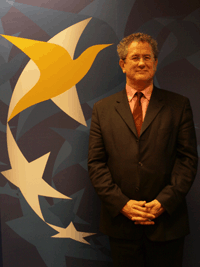The European Aviation Safety Agency's new rulemaking director Jules Kneepkens has been in the job since September, when Claude Probst stood down, so he has gained a feel for what is needed.
EASA, he says, is generally seen as being more efficient than the club of national aviation authorities it replaced, but there are many areas in which systemic improvement is required. Kneepkens reveals that a recent review by the EASA management board has identified a need to simplify EASA's working relationship with the national authorities and industry. Companies - particularly small ones - struggle to understand the EASA/national authority shared competency which, he says, is an essential part of the total system.
 |
|---|
© EASA |
Work on preparing EASA to take on the air traffic management/airports regulatory role has already begun. Eurocontrol is drawing up a roadmap for the transition, the European Parliament will be debating the enabling legislation in March, and EASA has been liaising with all the stakeholders. Kneepkens says EASA hopes, by 2010, to publish the plans for centralising air traffic management/airports regulation, says Kneepkens. He predicts airport regulation will be done mostly through acceptable means of compliance rather than hard rules.
FLIGHT TIME LIMITATIONS
The recently published EASA-commissioned scientific study into existing flight time limitations (Flight International, 27 January-2 February) says that the maximum existing pilot duty time limits carry an unacceptably high risk of dangerous fatigue. But Kneepkens says consideration of the economic impact of changes is also a required part of rulemaking. He adds that EASA has an open mind to regulation through fatigue risk management systems, which use the acceptable means of compliance principle. The NPA will be published soon.
EASA section manager for flightcrew licensing (FCL) Dr Annette Ruge, present with Kneepkens throughout the interview, points out that the deadline for comment on changes to FCL is close - the end of February. Changing to the EASA FCL is more than just a transposition of the existing Joint Aviation Requirements, says Ruge. Everything relating to flight training organisations in JAR FCL at present will be moved to the regulations covering organisations, and there is an additional NPA on precisely how the national authorities should implement the new FCL rules to ensure that they all interpret them the same way.
One change that is proving contentious is the proposed requirement for private pilots to undergo a skills test every six years. There will also be EASA licences - rather than national ones - for pilots flying gliders, airships, and balloons. But the national authorities will still issue all the licences, approve the flight training organisations and carry out the compliance checks.
In December, an EASA working group was set up to review the existing instrument rating to ensure it meets the needs of today's aviation environment. Also under study is the possible adoption of a European version of the UK Civil Aviation Authority-issued instrument meteorological conditions rating, a simpler test of instrument flying competence than the full instrument rating, but which does not confer any rights to fly in instrument flight rules airspace.
One of the most contentious proposals relating to FCL is that all instructors must hold at least the European licence and rating for the level to which he or she is teaching students. This matters because almost all the European training organisations have always carried out some of their schooling in the USA because it is cheaper and the weather is more reliable. At present they are permitted to use US Federal Aviation Administration-licensed instructors teaching to a JAR FCL syllabus, but under EASA flightcrew licensing this will no longer be allowed, and all the European trainers are seriously worried because they do not have enough European-qualified instructors to meet demand.
Kneepkens says the problem can only be solved if Europe and the USA create a bilateral agreement that includes FCL. But the European Commission - advised by EASA - and the FAA, are working on it, he says, adding: "The idea is not to disrupt something, it is to improve it." A draft bilateral between the European Union and America on airworthiness and certification issues has been prepared, and Kneepkens is at pains to point out that discussions are well advanced with the USA on extending the bilateral into the operations and FCL arenas.
There is a will on both sides to reach agreement, he says. April 2012 is the deadline for implementing the rules relating to the use of FAA-qualified instructors to teach European student pilots, and Kneepkens says it may be feasible to reach an agreement by that time.
Source: Flight International























